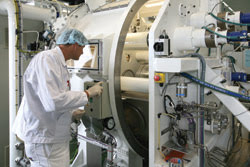
Solar infusion in the Netherlands
Several solar projects have received hefty subsidies as part of the Joint Solar Programme (JSP), which aims to promote research into photovoltaic solar energy in the Netherlands. JSP is funded by the Netherlands Organization for Scientific Research and by the Amsterdam-based company NV Nuon Energy.
Several universities also are participating in the program. Utrecht University received funding for projects involving solar concentrators based on luminescent-doped nanocrystals, on quantum-dot-based thin-film silicon cells and on low-cost luminescent concentrators, and for another project done in conjunction with Delft University of Technology that focuses on quantum-dot superlattice solar cells.

A researcher working with Nuon Helianthos in the Netherlands is overseeing the sputtering process, which is applying the reflective back contact of the solar cells.
Also, Nuon Helianthos, a subsidiary of NV Nuon Energy, which recently merged with Vattenfall AB, a Swedish government-owned energy group, has opened a test factory in Arnhem to produce a thin, flexible foil material for solar cells. Development of the technology began in 1996 with an invention made by industrial researchers at Utrecht University. Three years ago, Nuon acquired the solar cell foil producer Helianthos and, since that time, has been active in developing the technology.
Production facility planned
Once the tests are successfully completed, a production facility is planned in Arnhem that will manufacture 1 million square meters of solar laminate a year. One advance demonstrated at the test factory is the ability to produce a 120-cm-wide laminate, four times the width of previous production.
Published: September 2009